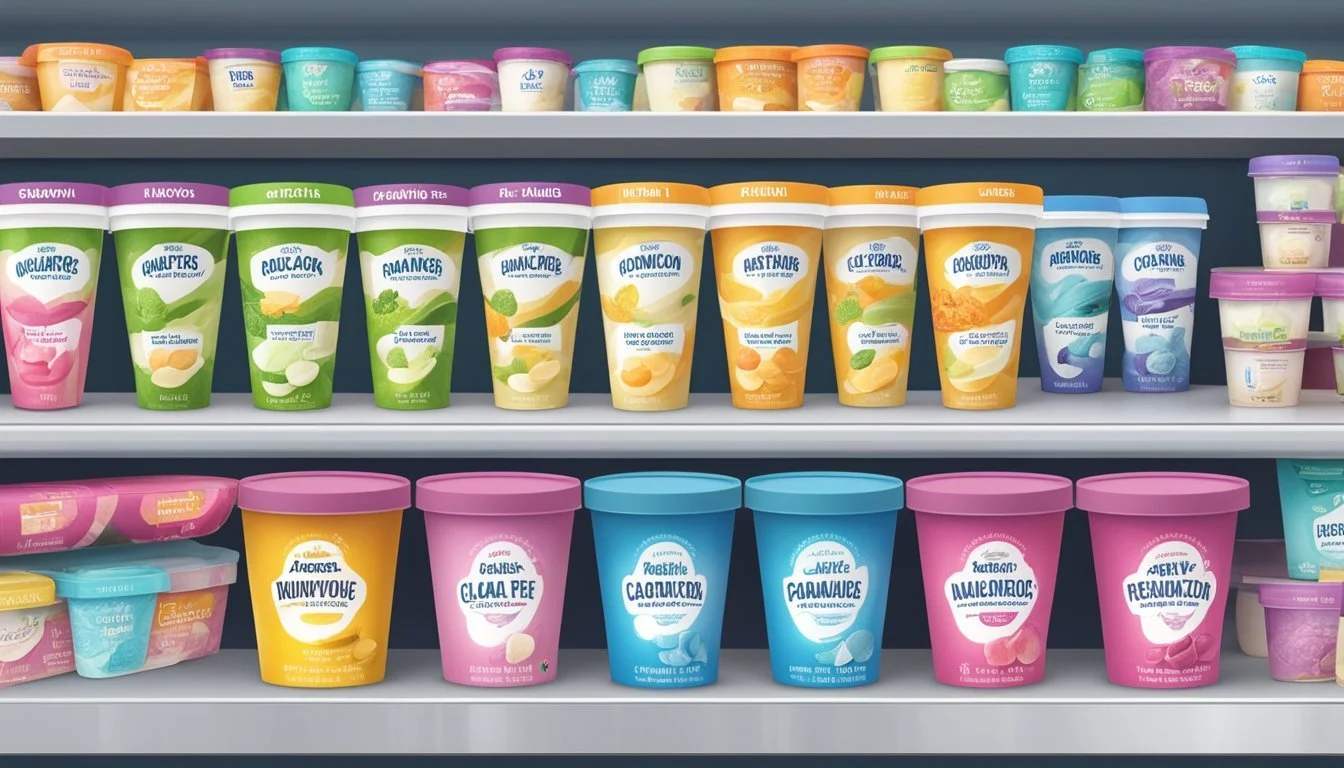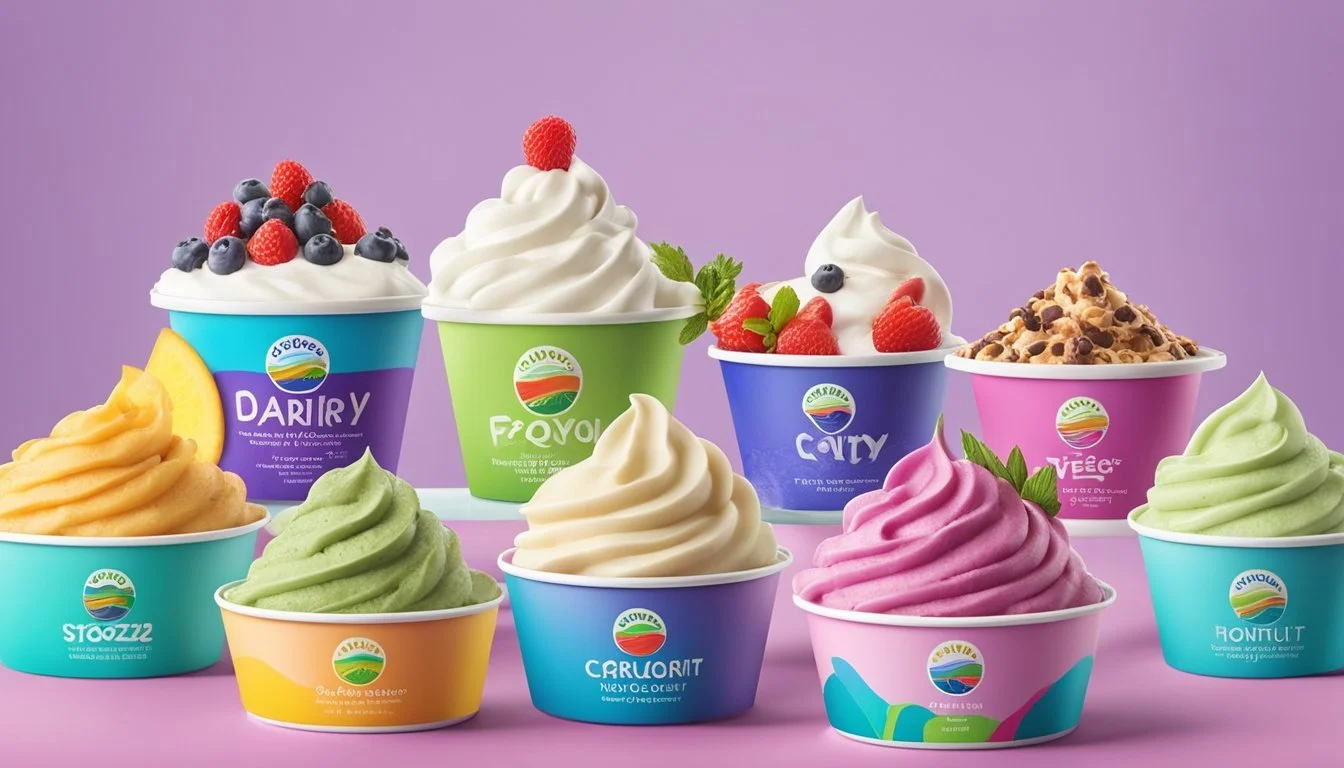What Are Some Lactose-Free Frozen Yogurt Options?
Exploring Dairy-Free Alternatives
Lactose-free frozen yogurt options have become a mainstay for consumers who are lactose-intolerant, vegan, or simply looking to avoid dairy for other health or ethical reasons. The market has responded to the growing demand by introducing a diverse range of frozen yogurts that are made without dairy and therefore contain no lactose. These products often utilize plant-based milk alternatives such as coconut milk, almond milk, and oat milk, serving as the base for creamy and flavorful desserts that can rival traditional dairy-based frozen yogurts.
Some popular brands that cater to the lactose-free audience have established a strong presence both in grocery stores and frozen yogurt shops. For instance, Pinkberry offers a selection of dairy-free frozen yogurts made from coconut milk base, providing flavors like Coconut Milk Cold Brew and Coconut Milk Lemon Crème. On the retail front, brands such as Cocoyo have revived their dairy-free offerings with probiotic-rich coconut-based yogurts that cater to health-conscious consumers.
Consumers now have a multitude of lactose-free options that do not compromise on taste or texture, making it easier than ever to enjoy frozen yogurt without the discomfort that can come from consuming lactose. As manufacturers continue to innovate, the variety of flavors and bases is expected to grow, reflecting the increasing importance of inclusivity in the food industry for those with dietary restrictions.
Understanding Lactose Intolerance
Lactose intolerance is a common digestive issue where the body is unable to fully digest lactose, a natural sugar found in milk and dairy products. This inability stems from a shortage of lactase, an enzyme produced by the small intestine that is essential for breaking down lactose into glucose and galactose—simpler sugars that the body can absorb.
When someone with lactose intolerance consumes dairy, undigested lactose passes into the large intestine where it becomes fermentable substrate for bacteria. This often leads to discomfort in the gut, presenting as symptoms such as bloating, gas, abdominal cramps, and diarrhea. These can occur anywhere from 30 minutes to two hours following the consumption of lactose-containing foods.
The condition varies in severity; some individuals can tolerate small amounts of lactose, while others might be more sensitive to any dairy intake. The management of lactose intolerance typically involves either the reduction or elimination of lactose from the diet, opting for lactose-free alternatives, or the use of lactase supplements to aid in the digestion of lactose.
It's important for individuals managing lactose intolerance to ensure they receive sufficient nutrients, particularly calcium and vitamin D, which are abundant in dairy products. A variety of lactose-free and lactose-reduced milk products are available and are nutritionally comparable to their lactose-containing counterparts. Additionally, some fermented dairy products, such as yogurt with live and active cultures, can be more easily digested as the bacterial cultures help break down lactose.
Dairy-Free Diet Basics
Adopting a dairy-free diet involves excluding products derived from animal milk, which prompts consideration of alternative sources for essential nutrients like calcium, protein, and vitamin D.
Benefits of Dairy-Free
Individuals may choose a dairy-free diet for various reasons ranging from allergies and intolerances to ethical beliefs. A dairy-free diet excludes the consumption of cow's milk and products made from milk such as cheese, yogurt, and ice cream. For those with a milk allergy or lactose intolerance, avoiding dairy can prevent allergic reactions and alleviate symptoms like stomach discomfort. Some people also report experiencing clearer skin and improved digestion after cutting out dairy.
Dairy-free diets can also align with ethical and environmental perspectives. Plant-based milk alternatives result in a lower environmental footprint compared to traditional dairy farming. This diet also appeals to those seeking cruelty-free eating practices.
Nutritional Considerations
When eliminating dairy, it's important to ensure that one still receives ample calcium, protein, and vitamin D from other sources to maintain a well-balanced diet. Plant-based alternatives and fortified foods can provide these essential nutrients.
Nutrient Plant-based Sources Calcium Fortified plant milks (almond, soy, rice), tofu, broccoli, kale, almonds Protein Lentils, chickpeas, quinoa, tempeh, hemp seeds Vitamin D Fortified foods, sunlight exposure, supplements
It is recommended to read labels with caution, as some products may contain dairy-derived ingredients despite being labeled as "non-dairy" or "dairy-free." Individuals should consult with a healthcare provider or a nutritionist to ensure that their nutritional needs are met on a dairy-free diet.
Frozen Yogurt Alternatives
For those seeking dairy-free frozen treats, there are ample options ranging from lactose-free frozen yogurts to vegan-friendly iterations, as well as refreshing sorbets that cater to various dietary preferences.
Lactose-Free Frozen Yogurt
Lactose-free frozen yogurt offers a creamy texture akin to traditional frozen yogurt but without lactose, ensuring it's digestible for those with lactose intolerance. Manufacturers often substitute lactose with other sugars to retain the sweet flavor. These products still contain dairy-derived ingredients, thus preserving the probiotic benefits associated with yogurt. The key differentiator here is the absence of lactose.
Vegan Frozen Yogurt
Vegan frozen yogurt eliminates all animal products, using alternatives like coconut milk, almond milk, or soy milk as the base. Vegan options are not only lactose-free but also to cater to those following a plant-based diet. Brands like Pinkberry offer coconut milk-based flavors including Coconut Milk Cold Brew and Coconut Milk Lemon Crème, ensuring the frozen yogurt experience without dairy.
Sorbets and Ices
Sorbets and ices are fruit-based and do not contain dairy, making them an excellent alternative for those avoiding all animal products. These frozen desserts are celebrated for their intense fruit flavors and are typically free from fat and cholesterol. While they don't contain the probiotics found in yogurt-based products, sorbets are a light, palate-cleansing option available in a plethora of flavors.
Identifying Dairy Alternatives
When seeking lactose-free frozen yogurt alternatives, consumers have a variety of plant-based options. These alternatives provide rich textures and flavors that cater to different dietary needs and preferences.
Soy-Based Options
Soybeans offer a reliable substitute for dairy in frozen yogurt. Soy-based frozen yogurt is a popular alternative due to its creamy texture and high protein content. Products made from soy cater to those avoiding dairy while ensuring the intake of essential nutrients.
Products: Soy-based frozen yogurts
Nutritional Profile: High in protein, contains essential amino acids
Coconut-Based Options
Coconut milk is celebrated for its rich and creamy characteristics, making it a favorite base for dairy-free frozen yogurt. Noted for a subtle tropical flavor, it complements a wide range of yogurt flavors. Coconut milk-based options are often enhanced with probiotic cultures for added health benefits.
Products: Coconut milk frozen yogurts, Coconut Milk Cold Brew, Coconut Milk Lemon Crème
Benefits: Natural sweetness, probiotic-enriched varieties
Oat Milk and Other Nut Milks
Oats and nuts provide additional avenues for dairy-free frozen yogurt. Oat milk is appreciated for its environmental sustainability and allergen-friendly profile. Nut milks, including almond, represent a nutritious dairy alternative without compromising on taste or texture.
Options:
Oat Milk: Mild flavor, eco-friendly
Almond Milk: Slightly nutty taste, nutrient-rich
Considerations: Nutritional content varies; some options may contain added sugars or flavors
Reading Labels for Lactose-Free Products
When selecting frozen yogurt, consumers with lactose intolerance need to carefully examine product labels to ensure they are choosing lactose-free options. Label certification and ingredient lists provide critical information for making informed choices without compromising dietary needs.
Lactose-Free Certification
Certified lactose-free products have undergone testing to verify they meet specific criteria for containing no lactose. These products should display a clear lactose-free label or certification from a recognized authority. Always look for markings such as "lactose-free" or symbols indicating the absence of lactose. In the absence of standard regulations for the use of "lactose-free," it's prudent to check if a third-party organization has certified the product.
Organic Certification: Organic labels may also appear on lactose-free products and indicate adherence to organic farming principles, but they do not inherently guarantee a product is lactose-free.
Added Sugar: Some lactose-free frozen yogurts may have added sugars to enhance flavor, so checking the label for sugar content is advisable.
Understanding Ingredients
The ingredients list is a definitive tool for identifying traces of lactose. A lactose-free claim indicates that a product should not contain any milk-based ingredients such as milk, whey, or casein. However, consumers should be aware that lactose-free does not mean milk-free; a product may contain milk proteins yet have the lactose removed.
Common Lactose-Containing Ingredients to Avoid:
Lactose
Milk solids
Milk by-products
Whey
Caseinates
Milk sugar
Common Lactose-Free Indicators:
Lactase enzyme (added to help break down lactose)
Plant-based milk alternatives (almond, soy, coconut, etc.)
Inspecting labels for both certified claims and a thorough review of the ingredients list is vital in making an appropriate selection.
Health Benefits of Dairy-Free Yogurts
Dairy-free yogurts often include live probiotics and offer advantages for those with specific dietary needs or health considerations. Without compromising on the essential nutrients found in traditional yogurts, they provide a beneficial alternative.
Digestive Health
Dairy-free yogurts, such as those made from almond, coconut, or soy bases, typically contain live probiotic cultures. Probiotics are beneficial bacteria that play an essential role in maintaining gut health by supporting a balanced gut microbiome. With digestive wellness at the forefront, lactose-free yogurts allow individuals with lactose intolerance to enjoy yogurt's probiotic benefits without experiencing the discomfort associated with lactose digestion. Regular consumption may lead to improved digestion and can help in managing certain gastrointestinal conditions.
Reduced Allergies
Yogurts that are free from dairy cater to more than just a vegan diet; they also serve those with dairy allergies. Allergies to cow's milk can trigger various symptoms, ranging from skin reactions to digestive issues. Opting for dairy-free yogurt provides a safe alternative for those allergic to dairy, eliminating the risk of such reactions. Additionally, by avoiding the allergens found in dairy products, individuals can enjoy yogurts without the inflammation that can be prompted by intolerance or allergy to dairy.
Flavor and Texture Profiles
Lactose-free frozen yogurt offerings cater to a wide range of taste preferences, balancing flavor intensity with varied texture profiles. From the zest of fruit-infused varieties to the indulgence of thick, creamy textures, and the wholesome simplicity of unsweetened options, the lactose-free frozen yogurt market satisfies diverse palates.
Fruit-Infused Varieties
In the world of lactose-free frozen yogurt, fruit-infused flavors stand out for their vibrant taste and natural sweetness. These varieties often incorporate real fruit purees or chunks, adding a burst of freshness to every spoonful. Common fruit flavors include:
Strawberry: A classic choice with its bright and slightly tart profile.
Mango: Offers a tropical sweetness with a rich, velvety texture.
Fruit-infused lactose-free frozen yogurts can also be found in exotic and seasonal varieties, providing a refreshing and naturally sweet experience.
Creamy and Thick Textures
Those seeking a luxurious mouthfeel gravitate towards creamy and thick textures reminiscent of traditional dairy-based frozen yogurt. Despite the absence of lactose, these options achieve their rich consistency through the use of:
Coconut cream: Provides a full-bodied creaminess.
Plant-based thickeners: Such as carrageenan or guar gum.
The skillful blending of these ingredients results in lactose-free frozen yogurts that are both velvety and satisfyingly dense.
Unsweetened and Low-Sugar Options
For consumers mindful of sugar intake, unsweetened and low-sugar lactose-free frozen yogurts present a desirable choice. These options typically have a milder flavor profile and may use alternative sweeteners or rely solely on the natural sugars from fruit and other ingredients. Unique characteristics include:
Minimal to no added sugars.
The subtle sweetness brought forth by the main ingredients rather than overpowering sugary additives.
These lactose-free frozen yogurts provide a guilt-free indulgence for those looking to enjoy a frozen treat with less sugar.
Brand Recommendations
A variety of lactose-free frozen yogurt options cater to different tastes, with some brands focusing on widespread availability and others on organic, artisanal qualities.
Top Lactose-Free Brands
Brands like Silk and So Delicious lead the pack in lactose-free frozen yogurt options. Silk offers a range of products including the Silk Almondmilk Yogurt Alternative, which comes in various flavors, ensuring a wide array of choices for consumers with lactose intolerance or dairy sensitivities.
So Delicious: Known for its dairy-free products, this brand provides frozen yogurt made from alternatives like coconut milk and almond milk. They offer a diverse selection of flavors and are a go-to for those seeking a dependable, lactose-free option.
Artisanal and Organic Picks
For those partial to organic and artisanal selections, Cocojune and Forager Project provide options that are not only lactose-free but also cater to a more organic lifestyle.
Cocojune: This brand is recognized for its organic, plant-based yogurts. They have a reputation for using high-quality, sustainably sourced ingredients, making them a top pick for the environmentally conscious consumer.
Forager Project: They are committed to producing organic, dairy-free yogurts made from cashews. Their products are a testament to the brand's artisanal approach, appealing to those who favor organic ingredients and a rich, creamy texture in their frozen yogurt.
Creating Your Own Dairy-Free Frozen Yogurt
Those seeking a lactose-free alternative to traditional frozen yogurt have various options to create delicious, creamy treats without dairy. These recipes leverage ingredients like coconut cream to replicate the smooth texture and can easily be customized with a variety of toppings.
Home Recipes
Homemade dairy-free frozen yogurt is simple to prepare with the right ingredients. The base typically requires a dairy-free yogurt alternative, such as coconut yogurt, which offers a rich, creamy texture akin to classic frozen yogurt. A straightforward method involves blending the dairy-free yogurt with frozen fruit until smooth. Here's a basic recipe framework:
Select your base: Choose a high-quality dairy-free yogurt like coconut, almond, or soy.
Pick your fruit: Use frozen fruit for a thicker texture; berries, mango, and banana are popular choices.
Sweeten if needed: Depending on your taste, sweeten with natural sweeteners like honey (for non-vegans) or maple syrup.
Blend: Combine ingredients in a food processor or high-speed blender until smooth.
Freeze: Transfer the mixture to a freezer-safe container and freeze until it reaches the desired consistency.
For an individual serving, a basic ratio to follow is:
1 cup of frozen fruit
1/2 cup of dairy-free yogurt
Sweetener to taste (optional)
Customization Ideas
The joy of homemade frozen yogurt lies in its versatility. Personalize your dairy-free frozen yogurt by experimenting with an array of toppings and mix-ins. Here are some suggestions to tailor your frozen treat:
Fruits: Add fresh fruit like kiwi, pineapple, or berries for a refreshing twist.
Nuts & Seeds: Incorporate a crunchy element with chopped nuts or a sprinkle of chia seeds.
Chocolate: Dairy-free chocolate chips or a drizzle of dark chocolate can satisfy a sweet tooth.
Superfoods: Mix in acai powder or matcha for a nutrient-packed version.
Flavor Extracts: Enhance the taste with natural extracts like vanilla or almond.
A table of popular toppings for inspiration:
Category Toppings Fruits Mango, Blueberries, Raspberries Crunch Almonds, Walnuts, Granola Sweet Vegan Chocolate Chips, Coconut Flakes Superfoods Goji Berries, Cacao Nibs
In the creation of dairy-free frozen yogurt, one has the freedom to cater to their palate while maintaining a lactose-free diet. With these guidelines, anyone can craft their very own signature frozen dessert.
Nutritional Impact of Dairy-Free Frozen Yogurt
The nutritional profile of dairy-free frozen yogurt can vary based on ingredients used, with specific attention to protein content and levels of saturated fat and sugar.
Protein Content
Dairy-free frozen yogurt often replaces dairy with alternatives such as soy, almond, or coconut bases. These alternatives inherently change the protein content. For instance, an almond milk-based frozen yogurt may contain less protein on average compared to traditional dairy-based options. In contrast, soy-based products might offer a protein content comparable to dairy, given that soy is a complete protein source.
Nutritionally, protein is essential for muscle repair and growth, and adequate consumption is crucial for overall health. Consumers should look at the nutritional labels to determine the exact protein content to ensure they meet their dietary requirements.
Saturated Fat and Sugar Levels
While traditional frozen yogurt may contain higher levels of saturated fats due to their dairy content, many dairy-free alternatives tend to be lower in these fats. However, it is imperative to consider that some plant-based alternatives, like coconut milk, may contain higher levels of saturated fat.
Sugar content in dairy-free frozen yogurt also varies notably by brand and flavor. Some options are sweetened with natural sweeteners or fruit purees, which can contribute to a lower sugar content, while others might include added sugars, increasing the calorie count. For health-conscious consumers, checking the label for added sugars is vital as consuming high amounts of sugar can lead to health issues over time.
Allergies and Sensitivities
When exploring lactose-free frozen yogurt options, individuals must consider specific dietary needs such as allergies and sensitivities to common ingredients like nuts, soy, and dairy products.
Identifying Common Allergens
Various ingredients found in frozen yogurt can trigger allergic reactions. The primary concern for those with lactose intolerance is dairy products, which are often replaced with plant-based alternatives in lactose-free options. However, these substitutes can introduce new allergens into the diet. Common allergens include nuts, soy, and sometimes gluten or eggs, which are used in certain flavorings or additives.
For individuals with nut allergies, almond-based yogurts are unsuitable, while soy-based products should be avoided by those with soy allergies. It is crucial to thoroughly check the ingredient list on any lactose-free frozen yogurt for potential allergens, as well as for cross-contamination warnings.
Nut-Free and Soy-Free Options
Several brands offer nut-free and soy-free frozen yogurts to cater to individuals with sensitivities or allergies to these ingredients. Here is a list of some available options:
Coconut-based yogurt: A popular alternative that is generally safe for those with nut and soy allergies.
Oat-based yogurt: Usually free from nuts and soy, but one must ensure it's also gluten-free if there is a gluten sensitivity.
Rice-based yogurt: Less common but a viable option for those avoiding nuts and soy.
When selecting a product, it's important for individuals to verify that it is indeed nut-free or soy-free by looking for certifications or allergen statements on the packaging. It's also advisable to research the manufacturer's allergen policies to determine if there is a risk of cross-contamination during production.
Desserts and Pairings
Lactose-free frozen yogurt is versatile, pairing well with a myriad of complementary foods and toppings to elevate the dessert experience. These can range from fresh fruits and nuts to granola, providing texture and flavor contrasts that enhance the yogurt's base.
Complementary Foods and Toppings
Fruits: Fresh fruits provide a natural sweetness and tartness that can accentuate the flavor profile of lactose-free frozen yogurt. Here are some fruit options to consider:
Strawberries
Raspberries
Mango
Nuts: For a crunchy contrast, nuts are an excellent topping that adds not only texture but also a rich taste. Some preferred nuts include:
Almonds
Walnuts
Pecans
Granola: A sprinkle of granola can introduce a wholesome crispiness to the creamy dessert. Opt for a granola with a hint of honey or maple syrup for added depth.
Healthy Dessert Ideas
Frozen yogurt can also be a part of a healthy dessert strategy, especially when mindful of the toppings and pairings chosen. Here are some wholesome ideas to consider:
Parfait: Layer lactose-free frozen yogurt with fruits and a light sprinkle of granola to create a balanced parfait.
Smoothie Bowls: Blend lactose-free frozen yogurt with a mix of fruits and pour into a bowl. Add a scoop of granola and a selection of nuts for a nutritious treat.
Fruit Salad: Mix lactose-free frozen yogurt with a fruit salad for a refreshing and health-conscious dessert option.
By smartly choosing toppings and pairings, one can enjoy lactose-free frozen yogurt in various delicious and healthful ways.














